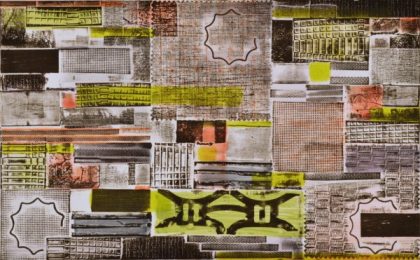Jeanniot’s ‘The Horrors of War’ Etchings – Discovery & Restoration
The ‘lost’ series of ten copper etching plates made to produce the World War One etchings detailed in a previous article were bought on eBay, unattributed to Pierre-Georges Jeanniot, in December 2013. The vendor had acquired them earlier in the year in France, where they had been discovered in a loft. Although I didn’t know exactly what they were when I bought them, I recognised the quality of the work, the fact that it appeared to be a series, and the notable subject matter and its precedents.
The ten plates were contained, with a small quantity of other plates, in a custom-made, lockable pinewood box which bears two labels. One is hand-written with an address in Paris (171, Avenue Victor Hugo) and two are paper railway labels indicating travel from the Gare St Lazare in Paris to the seaside town of Lion-Sur-Mer near Caen, Normandy. Since this is far from Jeanniot’s country estate at Dienay, it is possible that the box travelled with the artist when he visited the area to paint scenes of French middle classes at the seaside. The whereabouts of the box of plates from that time onwards is unknown. At some point, however, it must have been separated from Jeanniot.

The plates were contained in thick paper envelopes, many of which had etchings applied to their exteriors indicating their contents. Some bear Jeanniot’s hand-written name. Many of the plates had been coated in a thick, dark-brown layer of varnish or lacquer, which may have been made from shellac or tar. This must have been applied by Jeanniot once the series had been banned, in order to protect the etched surfaces from corrosion.

The varnish/lacquer had to be removed in order to ascertain the condition of the plates, restore them and prepare them for printing. Master printmaker and restorer Martin Saull used a strong solvent to remove the stubborn dried residue of this layer. Once it had been removed, it became clear that Jeanniot’s plates had been coated in a microscopically thin layer of steel. A more durable metal than copper, this would have enabled a quantity of etchings to be taken from the plates without wearing the surface down as each etching was taken. In places, the steel had corroded. The facts that the plates were steel-faced and that a custom-made box had been produced to hold them indicates that Jeanniot held them (and his time and financial investment) in high esteem and had intended to produce a sizeable edition of the etchings.


The old steel layers and corrosion were professionally removed and the clean copper plates were electroplated with a fresh layer of protective steel. Following examination, it became clear that the crisp state of the plates and old layer of steel indicated that only a very few etchings had been taken from them in 1915. This is consistent with the fact that the series was quickly banned by the police when first exhibited.
Martin Saull was able to take a test printing from the plates in advance of producing the final limited edition. The ink used for the final edition is a French dark sepia ink by Charbonnel, and the paper is a French off-white 280gsm 100% cotton rag by B. F. K. Rives. These materials were chosen as they are likely to be
very close to those that Jeanniot may have chosen had he been able to print his planned edition.

A ‘straight’ printing method appeared too austere, so Martin Saull employed a retouchage (retouching) technique in which the wiping scrim is lightly dragged across the image as a final step before printing. This has the effect of enriching the lines, thus improving the tonal qualities. Great skill and care is required in order not to affect the white areas generated by the unworked areas of the plates, as it is certain that Jeanniot intended these to stand out.
Neither aquatint nor any other tonal techniques were used by Jeanniot, and all the details were produced with straight lines. Lights and darks are dependent on the varied depth of the drawn, etched lines, and the relative closeness of the lines impart tone, depth and atmosphere. As well as being revealed and finally published nearly a century after they were produced and subsequently lost, we hope that the resultant etchings would have pleased Jeanniot and met his high standards.
About the author
After being a specialist at Bonhams and Sotheby’s in London, Mark Hill joined an internet company where he became a director, running its exclusive alliance with eBay. For the past twelve years, he has written for Miller’s, the internationally renowned publisher of books on antiques and collectables. After founding Mark Hill Publishing Ltd in 2006, he is now an independent author, publisher, lecturer and dealer in 20thC design and restruck prints. He is also an expert on the BBC Antiques Roadshow and has co-presented three landmark primetime series on antiques and collecting for BBC2.
The Horrors of War is available in a numbered limited edition of 250 of each etching. Each of these posthumous impressions is priced at £220, or £1,750 for the full set of ten etchings contained in a museum quality, archive portfolio together with an illustrated, explanatory book. The full set of etchings can be viewed and bought at Mark Hill, Grays Mews Antiques, 1-7 Davies Mews, London W1K 5AB or via www.thehorrorsofwar.com.


